PASSING LÜDERITZ
ref. # 030 passing Lüderitz -Diogo Cão
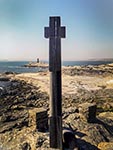 Here, in 1485, the Portuguese captain and navigator Diogo Cão landed. He was the first European to set foot in Namibia, indeed, the first European of his time to reach this far south down the coast of Africa. To mark the achievement he erected a stone cross on the bleak headland. It was a 2 metre high, 360kg commemorative stone, or padrão, (a tribute to João II) at Cape Cross in honour of King John I of Portugal. It was inscribed in Latin and Portuguese with:
Here, in 1485, the Portuguese captain and navigator Diogo Cão landed. He was the first European to set foot in Namibia, indeed, the first European of his time to reach this far south down the coast of Africa. To mark the achievement he erected a stone cross on the bleak headland. It was a 2 metre high, 360kg commemorative stone, or padrão, (a tribute to João II) at Cape Cross in honour of King John I of Portugal. It was inscribed in Latin and Portuguese with:"Since the creation of the world 6684 years have passed and since the birth of Christ 1484 years and so the illustrious Don John has ordered this pillar to be erected here by Diogo Cão, his knight."
alfakom.se/specks/padrao.htm
link: www.pinterest.com/WATERartproject/2014-passing-lüderitz/
©:
tags: #Luderitz #Diogo Cao
ref. # 030a passing Lüderitz -Bartolomeu Dias
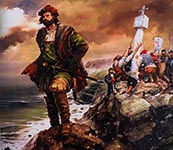 Bartolomeu Dias no Cabo. 1997
Bartolomeu Dias no Cabo. 1997Publicada por nonas á(s) 2.7.12
In December 1487 Dias sailed down the African coast, landing in among other places present-day Angola and Walvis Bay, Namibia. During this voyage, strong winds forced him to sail over a thousand kilometers off-course, and thus he sailed around the southernmost tip of Africa. He named the Cape "the Cape of Storms" (Cabo das Tormentas), but King John II of Portugal later renamed it Cabo de Boa Esperanca (Cape of Good Hope)."
Carlos Alberto SANTOS, painter, produced the Exhibition ´Vasco da Gama and the Discovery of the Oceans´ during the 16th Music Festival in Leiria, with the sponsoring of the Gallery Capitel and its owner, Joaquim Vieira. "If something exists - beyond love and friendship - that can give a meaning to life, it is the beauty of art.", in the words of Riemen.
YouTube
©: Pintura do Mestre Carlos Alberto Santos
tags: #Bartolomeu Dias #Arte, #Carlos Alberto Santos #Cultura #Història de Portugal #Pintura
216 2014 travel journal -history of the Atlantic
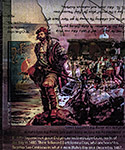 What is really a part of a testpage for printing ink, shows the dark and complex history of the discovery of the Atlantic Ocean.
What is really a part of a testpage for printing ink, shows the dark and complex history of the discovery of the Atlantic Ocean.©: Robert Schilder
tags: #history #Atlantic #Ocean
030b passing Lüderitz -Namibia in territories
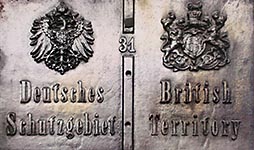 Namibia divided in territories
Namibia divided in territories©: photo Robert Schilder 2014
tags: #Namibia #territories
ref. # 030c passing Lüderitz -Land grabbing
 ´land grabbing´ (´landjepik´ in dutch ..)
´land grabbing´ (´landjepik´ in dutch ..)the German missionary Hermann Heinrich KREFT found diamonds near Lüderitz in 1855. He threw them away. When asked why, he answered: "What should I do with diamonds? They only bring tragedy to a country"
Adolf Eduard LÜDERITZ 'The scramble to colonize Africa'.
www.namibia-1on1.com
©:
, tags: #namibia #hermann heinrich kreft
030d passing Lüderitz -Hereros
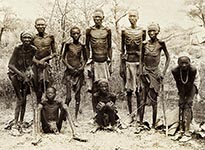 Group portrait of Hereros: survivors after an escape through the desert of Omaheke in 1905
Group portrait of Hereros: survivors after an escape through the desert of Omaheke in 1905Photographer: O. ZIEGLER. Views of German Southwest Africa. 1907-08
The Herero and Namaqua Genocide is considered to have been the first genocide of the 20th century. It took place between 1904 and 1907 in German South-West Africa (modern day Namibia), during the Herero Wars.
On 12 January 1904, the Herero people, led by Samuel Maharero, rebelled against German colonial rule. In August, German general Lothar von Trotha defeated the Herero in the Battle of Waterberg and drove them into the desert of Omaheke, where most of them died of thirst. In October, the Nama people also rebelled against the Germans only to suffer a similar fate.
In total, from 24,000 up to 100,000 Herero and 10,000 Nama died.The genocide was characterised by widespread death from starvation and thirst because the Herero who fled the violence were prevented from leaving the Namib Desert.
In 1985, the United Nations' Whitaker Report classified the aftermath as an attempt to exterminate the Herero and Nama peoples of South-West Africa, and therefore one of the earliest attempts at genocide in the 20th century. The German government recognised and apologised for the events in 2004, but has ruled out financial compensation for the victims' descendants. (Wikipedia).
From the Oranjemund river up to Lüderitz the coast is called "Sperrgebiet" -Forbidden Coast, because this is where the diamond mines are. The Sperrgebiet boundary is patrolled by some fairly ruthless characters and tresspassers will be prosecutes (Lonely Planet publications)
Some people never learn, do they?
link: www.liveauctioneers.com
and read more here: kora.matrix.msu.edu (.pdf file)
© Wikimedia Commons
tags: #namibia #genocide #herero
030e passing Lüderitz -Eugen Fischer
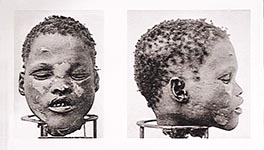 Geneticist Eugen Fischer came to German South West Africa on behalf of German universities as soon as the death camps (Shark Island) opened. Fischer´s ´race science´ theories led to the idea of a ´supreme race´ which not only severely influenced the Second Reich, but also the Third.
Geneticist Eugen Fischer came to German South West Africa on behalf of German universities as soon as the death camps (Shark Island) opened. Fischer´s ´race science´ theories led to the idea of a ´supreme race´ which not only severely influenced the Second Reich, but also the Third.read on www.ezakwantu.com
©: Public domain
tags: #eugen fischer #herero #namibia #genocide
197 2014 travel journal -Passing Lüderitz
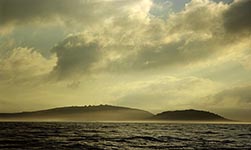 "Just about every view in Lüderitz reveals its German Imperial and Art Nouveau architectural heritage. But the German history of the area goes a lot further.
"Just about every view in Lüderitz reveals its German Imperial and Art Nouveau architectural heritage. But the German history of the area goes a lot further.The Herero and Namaqua Genocide is considered to have been the first genocide of the 20th century. It took place between 1904 and 1907 in German South-West Africa (modern day Namibia), during the Herero Wars.On 12 January 1904, the Herero people, led by Samuel Maharero, rebelled against German colonial rule. In August, German general Lothar von Trotha defeated the Herero in the Battle of Waterberg and drove them into the desert of Omaheke, where most of them died of thirst. In October, the Nama people also rebelled against the Germans only to suffer a similar fate
©: text: Wikipedia
picture from the exhibition
©: 2014 Robert Schilder
tags: #Luederitz #Namibia
